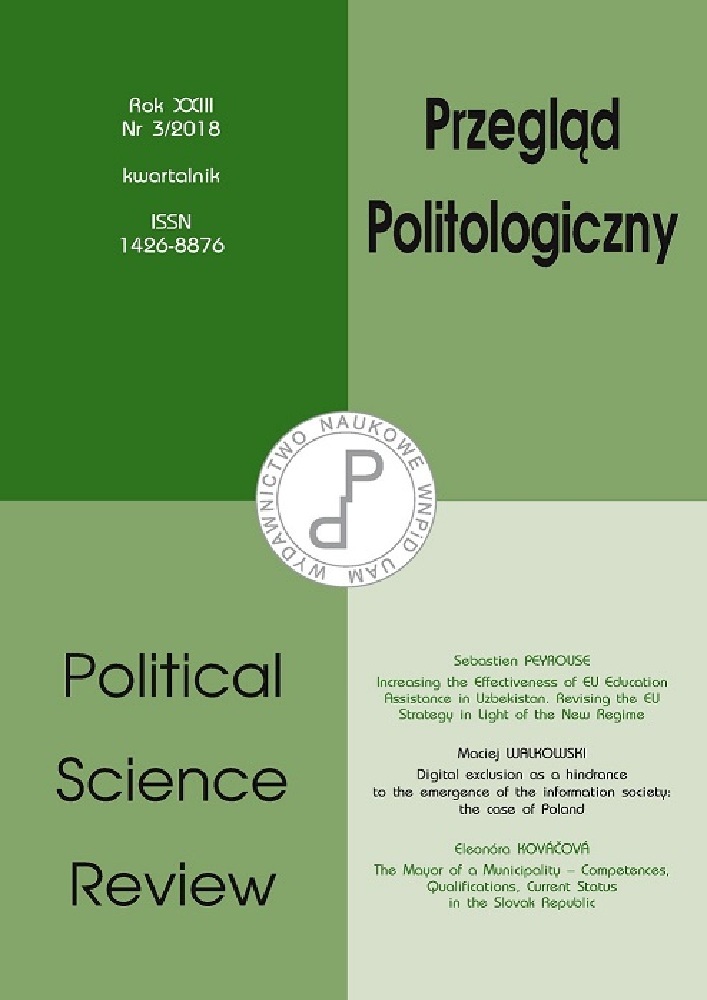Abstract
There is no doubt, that digital transformation (knowledge-based transformation) has emerged as the crucial megatrend in modern civilization. Artificial intelligence (AI), machines and autonomous vehicles, the Internet of Things (IoT), financial technology (Fin/Tech), smart investing and the analysis and processing of big data are the most recent manifestations of this trend, but not the only ones. All of these phenomena have led to the emergence and continuing development of the so-called ‘Information Society’ (IS), which refers to a new type of social organization that is clearly distinct from the earlier forms of society. In this new society, information and knowledge play an essential role in facilitating the Knowledge-Based Economy (KBE), where information is collected, transmitted and processed in a faster and more effective manner, and can subsequently be used to foster accelerated economic growth. Unfortunately, the problem of digital exclusion still occurs, also in Poland. The author in the conclusion comes to opinion that people who are digitally excluded find it much more difficult to overcome psychological rather than technical barriers to having access to the Internet and learning basic computer skills. This situation calls for urgent improvement. In the modern information society, a lack of basic knowledge about computers translates into partial or total digital illiteracy and makes it difficult to perform a range of everyday tasks. It is therefore essential in Poland to prevent digital exclusion. People who do not use the Internet are socially and professionally limited, or virtually handicapped, which results in quantifiable economic losses. This translates to lower creativity and innovativeness and reduced revenue of state budget, and impedes the competitiveness of the economy and the development of a post-modern, post-industrial social model. The main research goal is to show the causes of the phenomenon of digital exclusion in Poland and ways to counteract it. In the course of the research, the most frequently used method was causal and effect analysis as well as institutional and legal analysis. Elements of the decision-making, historical, comparative and statistical methods were also used.
References
miliardy internautów w 2015 r., Polska w Top 25 (2014), http://www.wirtualnemedia.pl/artykul/3-
miliardy-internautow-w-2015-r-polska-w-top-25, November 21, 2017.
Agomuoh F. (2014), Internet Expansion: Mobile Devices In Developing Markets To Push Web Usage Past 3 Billion In 2015, 20.11.2017.
Bangemann M., Europe and the Global Information, http://www.umic.pt/images/stories/publicacoes20080
/raport_Bangemanna_1994.pdf, January 22, 2018.
Cassey M. (2001), Europejska polityka informacyjna. Wyzwania i perspektywy dla administracji publicznej, Toruń.
Cieciura M. (2012), Wybrane problemy społeczne i zawodowe informatyki, Warszawa.
Digital in 2016 (2016), http://wearesocial.com/uk/special-reports/digital-in-2016, last access: May 09.
Digital in 2017: Global Overview (2017), https://wearesocial.com/blog/2017/01/digital-in-2017-global-
overview, January 22.
Dwornik B. (2008), To już 17 lat. Zobacz historię Internetu w Polsce, http://www.manager.money.pl/news/artykul/to;juz;17;lat;zobacz;historie;internetu;wpolsce,130,0,408706 e.html, May 09, 2017.
Facebook ma już 1,4 mld użytkowników dziennie (2018), https://mobirank.pl/2018/02/01/facebook-majuz-
-mld-uzytkownikow-dziennie-4q2018/, January 07.
Goban-Klas T. (1999), Społeczeństwo informacyjne: Szanse, zagrożenia, wyzwania, Kraków.
Goban-Klas T. (2007), Od społeczeństwa industrialnego do społeczeństwa informacyjnego, Kraków.
Goban-Klas T. (2005), Społeczeństwo medialne, Warszawa.
Grodzka D. (2009), Początki społeczeństwa informacyjnego, in: D. Grodzka, Społeczeństwo informacyjne, Warszawa.
Hargittai E. (2003), The Digital Divide and What To Do About It, Sociology Department Princeton University, http://www.eszter.com/research/pubs/hargittai-digitaldivide.pdf, October 27, 2017.
Historia 20 lat Internetu w Polsce (2011), http://www.gazetaprawna.pl/wiadomosci/artykuly/538332,historia_20_lat_internetu_w_polsce.html, August 15, 2017.
https://www.sas.com/pl_pl/insights/big-data/what-is-big-data.html, August 15, 2017.
Ip G. (2017), Pracownicy, nie lękajcie się (robotów), „The Wall Street Journal”, reprinted by “Gazeta Wyborcza,” October 27.
Jastrzębska A., Jastrzębska W. (2012), Wykluczenie cyfrowe – przyczyny, zagrożenia i bariery jego pokonania.
Studium przypadku, “Nierówności Społeczne a Wzrost Gospodarczy,” 25, pp. 91–104.
Krzysztofek K. (2002), Społeczeństwo informacyjne a rozwój człowieka, in: Polska na drodze do globalnego społeczeństwa informacyjnego, ed. W. Cellary, Warszawa.
Kare-Silver M. (2002), E-szok. Rewolucja elektroniczna w handlu, Warszawa.
Narodowy Plan Szerokopasmowy (2014), Ministerstwo Administracji i Cyfryzacji, January.
Papińska-Kacperek J. (2008), Społeczeństwo informacyjne, Warszawa.
Popiołek M. (2013), Wykluczenie cyfrowe w Polsce, “Nierówności Społeczne a Wzrost Gospodarczy,” 32, pp. 310–320.
Raport dotyczący cyfrowych trendów społecznych w świecie w roku 2016 (2016), http://wearesocial.com/uk/special-reports/digital-in-2016, February 13.
Statystyki dotyczące liczby użytkowników Internetu na świecie (2016), http://www.statista.com/statistics/273018/number-of-internet-users-worldwide/, February 13.
Senkus P. (2013), Zarządzanie i dowodzenie z wykorzystaniem orientacji procesowej. Sektor prywatny, sektor publiczny, sektor non profit, Wydawnictwo Difin.
Szczepański M. (2002), Zrozumieć rozwój. Od społeczeństw tradycyjnych do informacyjnych, Katowice.
Siciński A. (1999), Społeczeństwo informacyjne: próba nazwania naszych czasów. W drodze do społeczeństwa informacyjnego, Warszawa.
Strategia Rozwoju Społeczeństwa Informacyjnego w Polsce do 2013 roku, http://www.umwd.dolnyslask.pl/fileadmin/user_upload/spoleczenstwo_informacyjne/dokumenty/Strategia_Rozwoju_Spoleczenstwa_Informacyjnego_w_Polsce.pdf, October 15, 2017.
Tadeusiewicz R. (2002). Społeczność Internetu, Warszawa.
Understanding the Digital Divide (2001), Organisation For Economic Cooperation And Development,OECD, https://www.oecd.org/sti/1888451.pdf.
Wykluczenie cyfrowe w Polsce (2015), Kancelaria Senatu, Biuro Analiz i Dokumentacji, Zespół Analiz i Opracowań Tematycznych, December.
Wykluczenie cyfrowe. Problem, który dotyczy 9 mln Polaków, (2015), https://www.money.pl/gospodarka/wiadomosci/artykul/wykluczenie-cyfrowe-problem-ktory-dotyczy-9,77,0,1951309.html.
Wykluczenie cyfrowe: Edukacja ważniejsza od sprzętu (2015), http://www.portalsamorzadowy.pl/spoleczenstwo-informacyjne/wykluczenie-cyfrowe-edukacja-wazniejsza-od-sprzetu,71550.html.
Wykluczeni cyfrowo (2012), Badanie realizowane w ramach kampanii społecznej „Niech internetowa moc będzie z Tobą” finansowanej ze środków Ministerstwa Administracji i Cyfryzacji © TNS October 2015, pp. 10–11.
Wykluczenie cyfrowe: Edukacja ważniejsza od sprzętu (2015), http://www.portalsamorzadowy.pl/spoleczenstwo-informacyjne/wykluczenie-cyfrowe-edukacja-wazniejsza-od-sprzetu,71550.html.
Zacher L. W. (2006), Społeczeństwo informacyjne. Istota, rozwój, wyzwania, Warszawa.
Yildirim C. (2014), Exploring the dimensions of nomophobia: Developing and validating a questionnaire using mixed methods research, Iowa State University, Digital Repository, Graduate Theses and Dissertations, http://lib.dr.iastate.edu/cgi/viewcontent.cgi?article=5012&context=etd, November 1, 2017.
